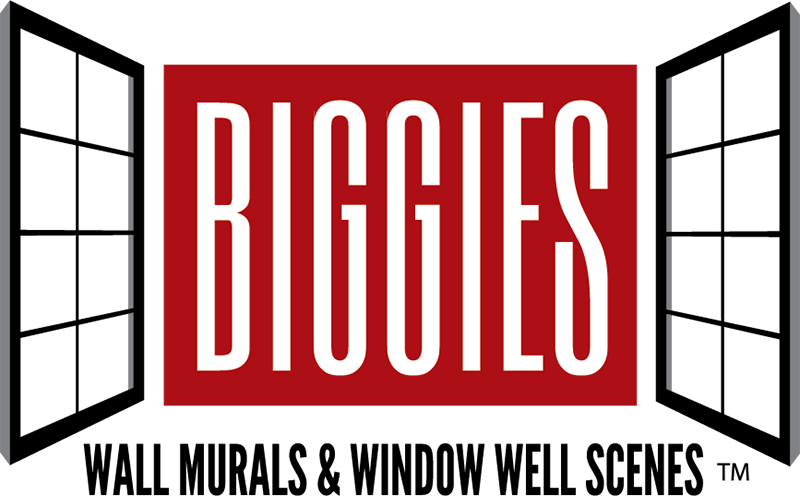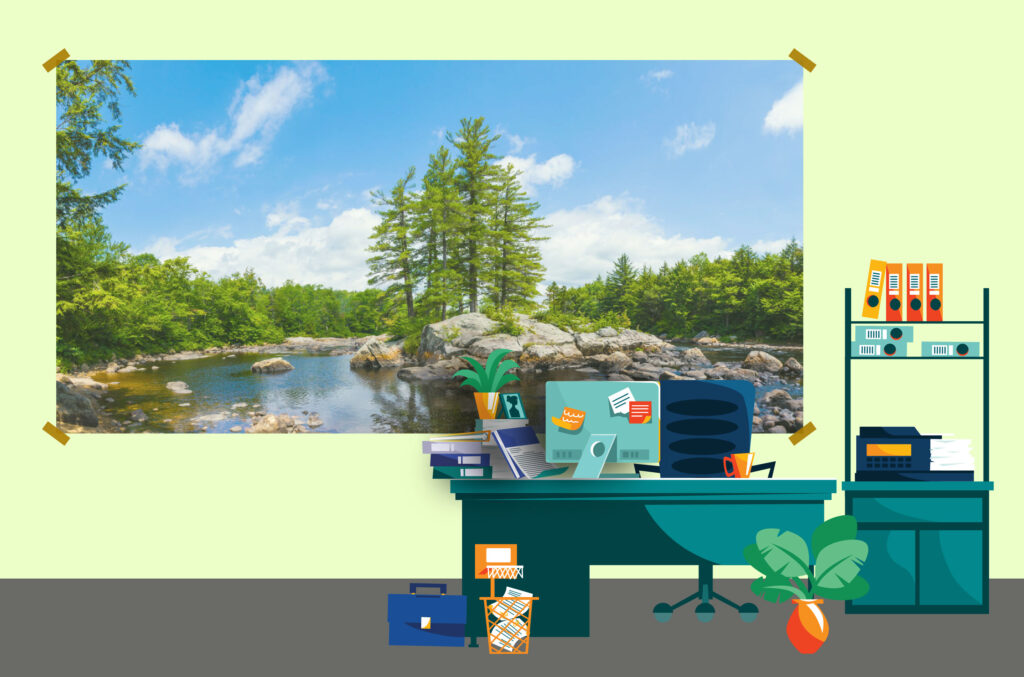Uncategorized
Cubicle Inspiration: Fresh Decor Ideas for Revitalizing Your Workspace
Moving into a new cubicle offers a rare chance to set the tone for how you work. Most cubicles are designed for neutrality, stripped of any personality and full of missed potential. But that blank canvas is an opportunity.
The best-designed cubicles start not with hauling every knick-knack or generic desk sign to the office. It begins by figuring out how to store your actual work. From towering stacks of paper to scattered pens and loose folders, it’s important to consider how you’ll store your work and supplies in a clean, structured way. Without a good plan for storing the tools you use the most, any stylistic theme will quickly become overpowered and any decor will be lost in the clutter. From there, it becomes about building a distinctive aesthetic that captures the eye and makes your workspace feel like a place you actually want to be.
These five fresh cubicle decorating ideas focus on layout, mood, lighting, and efficient use of space. Each one is designed for people who want to bring visual clarity and creative focus into their day-to-day.
1. Choose a Wall Mural to Anchor Your Aesthetic
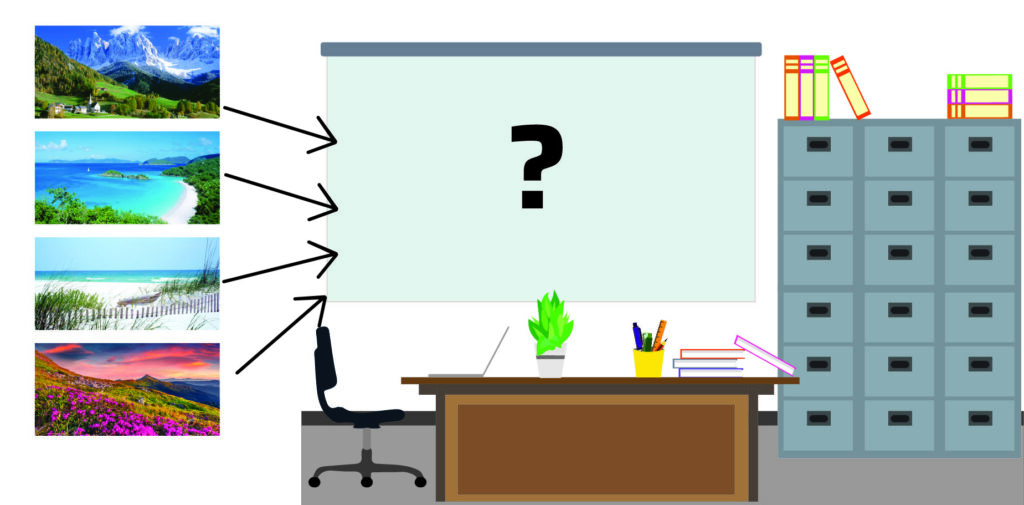
A wall mural instantly gives your cubicle clarity. It provides a backdrop, sets a mood, and establishes the visual identity of the space. Choose a wall mural specifically designed for office settings and that is easy to apply. Think: island cove views or a stunning mountainous landscape dotted with flowers. Statement wall murals and cubicle posters will lay the foundation for a complete work cubicle makeover.
Wall murals are also the best kind of cubicle wallpaper; they deliver more depth, intention, and visual cohesion than patterned paper or fabric. While traditional cubicle wallpaper often feels temporary or purely decorative, a mural offers visual structure that supports focus.
Some murals replicate natural scenes, which introduce a grounded, calming effect. Others use color and abstraction to build focus and energy. Choosing the right mural is less about trends and more about tone. It sets the baseline for every other element in your setup.
For a sense of openness and brightness, a sunny oceanic vista is ideal. Tropical backdrops with filtered sunlight and quiet blue tones pair naturally with neutral finishes, such as white shelving, stoneware organizers, and warm wood trays.
If you prefer something more textured and moody, consider choosing a nature-themed mural. This mural of Italy Valley depicts the structure of terraced hills and rugged moutains. It supports richer colors and soft textiles like linen and leather.
Apply the mural directly on the back wall of your cubicle, extending it across the entire wall space for the most immersive effect. Avoid overlapping it with other framed art or shelving. The mural should feel intentional and uninterrupted, serving as the visual anchor of your workspace. Every decor item that follows will reinforce the tone and texture of the mural you choose.
2. Use Vertical Space for High-Function Storage
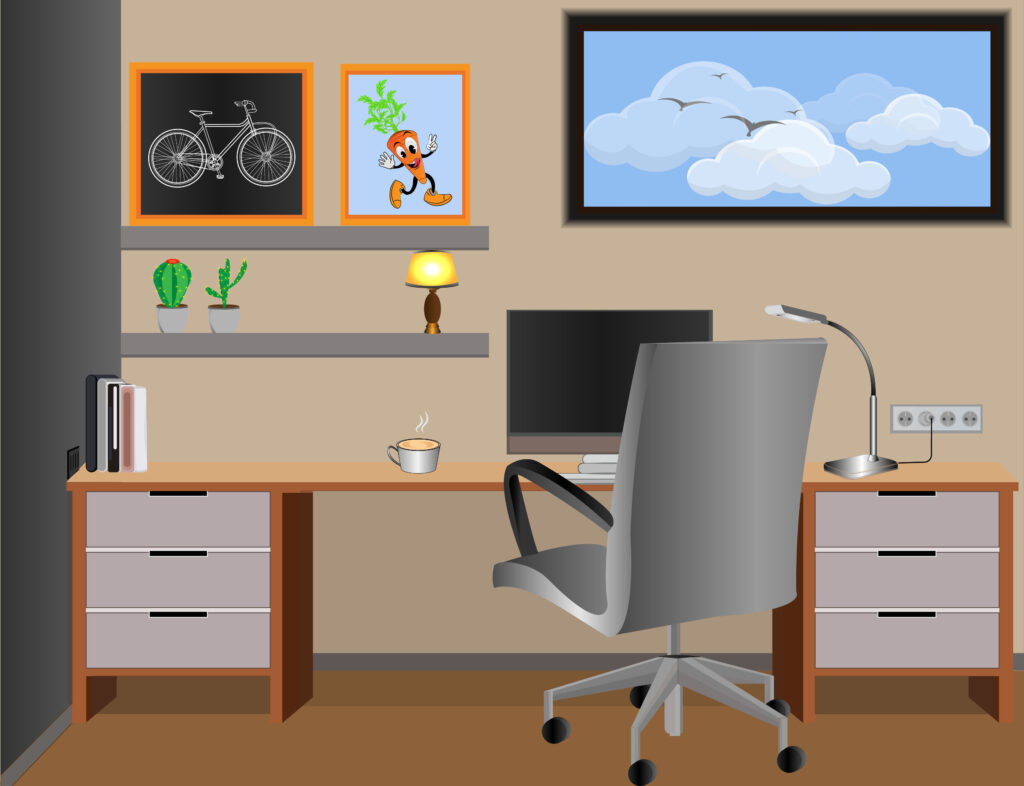
Most cubicles are built with limited horizontal work area, and horizontal clutter builds up quickly. One of the most overlooked cubicle decor ideas is using vertical space for both function and structure. Utilizing vertical space can improve general tidiness dramatically, ultimately allowing your decor to shine.
- If your cubicle is up against a wall, floating wall shelves are the most effective solution. Even one or two shelves can hold books, plants, or more functional containers for office supplies. Choose finishes that match your mural or other wall art—light wood, matte black, or white. Don’t overfill the shelves. A few well-chosen items keep the design intentional.
- If your cubicle doesn’t back against a wall, use plastic or glass shelf risers that sit directly on the desk. These create levels, again capitalizing on vertical space that is so often underutilized. Place some items below the shelf and others above, especially items that are not already stackable. This reduces clutter, increases accessibility, and makes the space feel less cramped.
For daily-use items like pens, sticky notes, paperclips, or charging cords, hang a plastic organizer directly on the cubicle wall using a command strip. Hanging plastic organizers are essential for keeping supplies visible but off your desk, preserving open space and maintaining a clean layout.
Vertical storage is essential in small office space design, and using it well makes your workspace feel more open, even without expanding the footprint.
3. Bring in Better Lighting
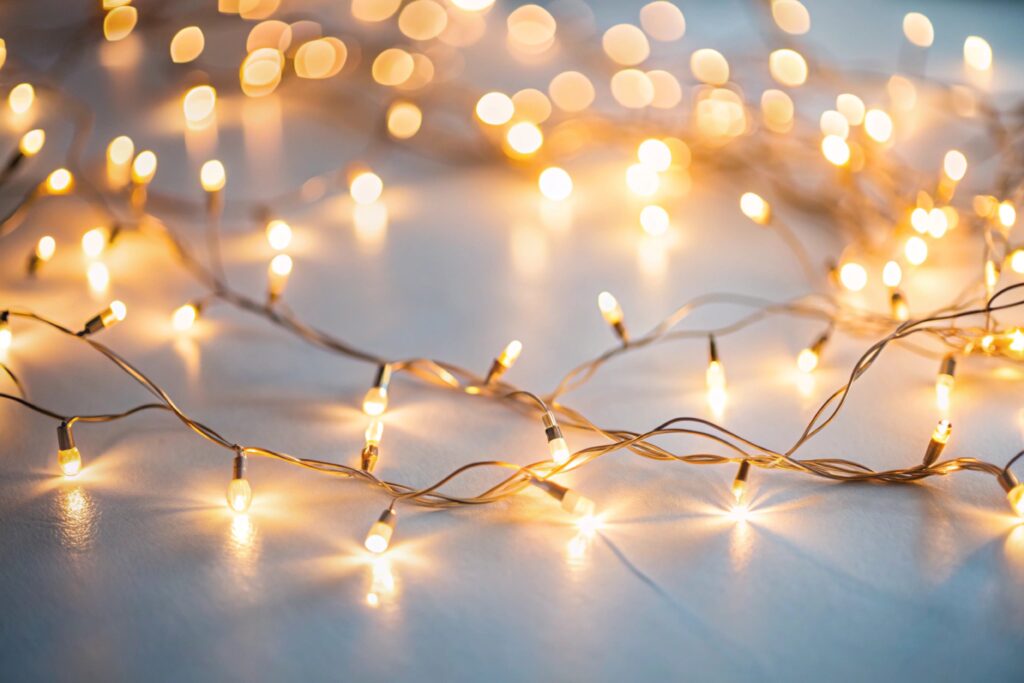
Interior design experts agree on… well, not much. Even the most renowned designers often have wildly different visions of what makes for the ideal aesthetic. However, there is consensus on one thing: good lighting is the holy grail of great design.
Office lighting is rarely flattering and frequently dingy. Harsh tones and uneven brightness can flatten the entire space and strain your eyes over time. Thus, lighting is a key element in any serious work cubicle makeover.
If you can place your desk near a window, do it, as natural light is the gold standard. If not, start with an overhanging lamp that mounts to the wall or clips to the side of your desk. Avoid bulky lamps that sit on your work surface and create clutter. Choose one with a soft LED glow and a dimmable setting. Look for finishes that match your existing hardware and decor, such as your desk, a wall mural, or other visual anchors in your office space.
String lights or fairy lights are another way to add atmosphere without taking up space on your desk. Wrap them cleanly around the edge of your cubicle wall or run them along a shelf edge. Stick with white or warm-toned bulbs to keep the lighting calm and even.
This is not about adding sparkle. It’s about correcting bad lighting and creating a workspace that helps you think more clearly. Lighting directly impacts mood and productivity.
4. Add One or Two Low-Maintenance Plants
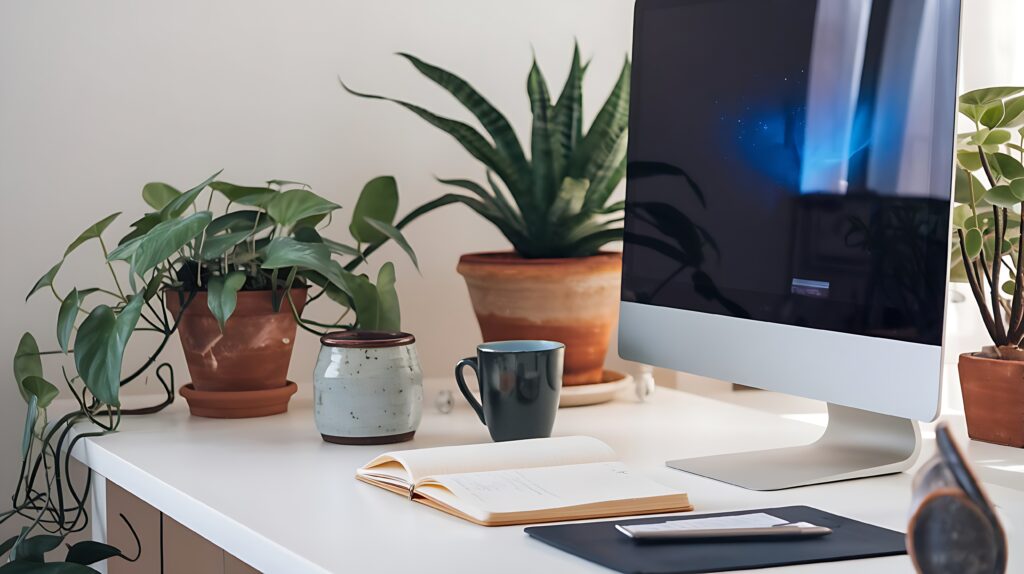
Plants make a cubicle feel cozy, lived-in, and welcoming. They also help soften harsh materials and bring movement into the space. If you’ve chosen a mural with a natural element, such as trees, water, or desert textures, you can match your plant choices to that tone.
Examples:
- Pair a forest mural with low-light plants with soft edges: pothos, zz plants, or small ferns.
- For brighter desert-style murals, try cacti, succulents, or aloe. These bring sculptural form without requiring much water.
- For soft beach scenes, try a chinese fan palm, a parlor palm, or the sago palm. These plants are stunning and reminiscent of tropical palm trees, reinforcing a cohesive aesthetic.
Place them either on your shelf, beneath your mural, or on the corner of your desk. Ensure that their pots match or compliment one another, as well as other key decor in your workspace.
Artificial plants can work too—but only if they’re high-quality. As one industry expert put it, “cheap-looking fake plants defeat the purpose.” While faux greenery has its haters, it has just as many fans. Moreover, the best artificial plants are the ones that go undetected, and precisely because they’re doing their job. Ultimately, getting it right comes down to knowing what to look for.
What to look for:
- Opt for individual stems rather than pre-arranged plants—this gives you full control over styling and allows you to reuse them in different vases or arrangements.
- Look for stems with a slightly wild or asymmetrical shape; the less perfect they are, the more natural they’ll appear.
- Choose bendable or wired stems so you can shape each piece to mimic the relaxed posture of real plants.
- Stick to varieties that already look somewhat artificial in real life, like succulents, fig leaves, maidenhair ferns, or boxwoods, as even the real versions often appear too flawless to be real.
- Keep your faux plants clean and out of direct sunlight; regular dusting goes a long way in keeping them fresh. Also, avoid sun exposure to prevent fading, especially for silk varieties.
Where to look for it:
Amazon can be a great source for finding faux plants, and of course the reliability of reviews and easiness of returns makes it a low-risk option. However, because there are so many retailers in the mix, finding a high-quality option can feel like searching for a needle in a haystack. Nonetheless, there are some excellent vendors with some incredibly life-like pieces, such as these faux tulips, featuring bendable stems and soft petals.
For a more reliable, high-quality faux plant resource, Pottery Barn Botanicals are a go-to. However, Pottery Barn tends to be on the higher-end price-wise.
Other resources include Afloral, Ballard Designs, and West Elm.
5. Create Under-Desk Storage That Hides Paperwork
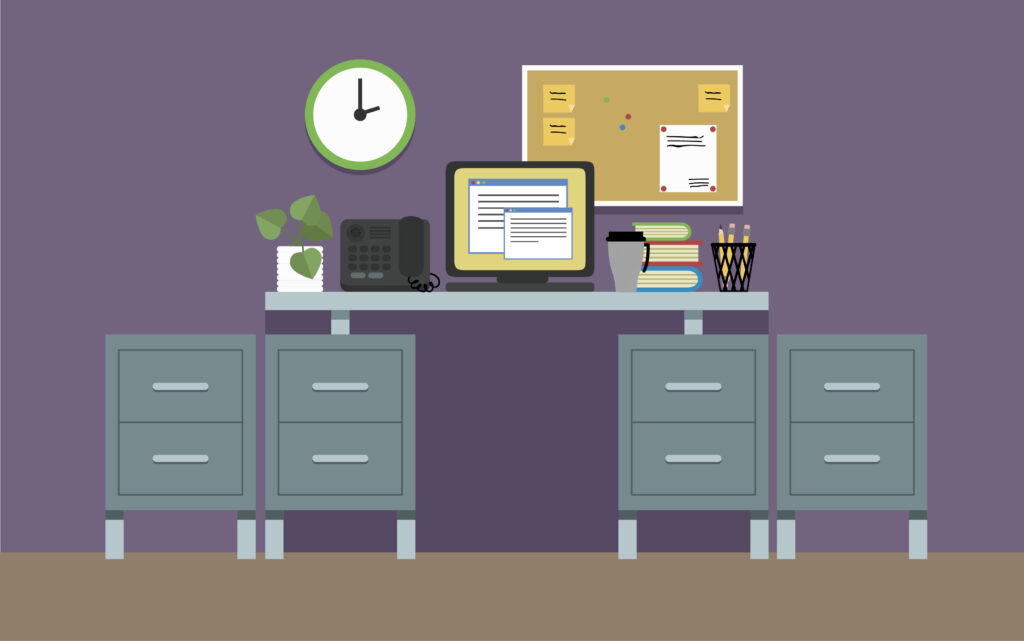
I said it before and I’ll say it again: the fastest way to ruin a beautiful cubicle layout is letting paperwork and supplies pile up on your surface. Clutter not only detracts from your carefully curated aesthetic, but it also makes it harder to work. How can you concentrate on the task at hand when there are visual reminders of every other to-do item surrounding you? The best personalized workspace ideas start with finding a handy under-desk drawer or cabinet to file away anything unrelated to the present assignment.
Consider using a rolling drawer unit that fits under your desk to keep daily-use folders and tools out of sight. Choose one with soft-close drawers or flat pull tabs so it blends in with the rest of your layout. If you prefer open containers, use bins that fit flush with the wall or under the riser shelves.
The right under-desk storage clears space for things that matter and supports a more flexible use of the desk overall. This is a simple way to shift your layout from chaotic to composed.
Closing Note
Choosing a distinct style starts with selecting a strong visual anchor, such as a wall mural, and then building on that theme with complementary plants, lighting, and decor. When chosen carefully, each design element can support your workflow and reinforce your overall theme.
Moreover, these five strategies are tried and true. They don’t just answer the question of how to decorate a cubicle with the latest and greatest Pinterest has to offer; these tips focus on the fundamentals for curating a workspace that endures over time. When the essentials are truly nailed down, that’s when your personalized aesthetic can best shine through.
